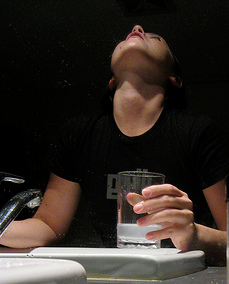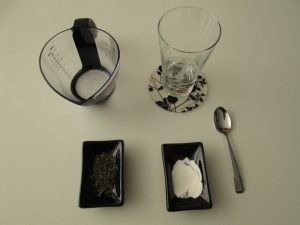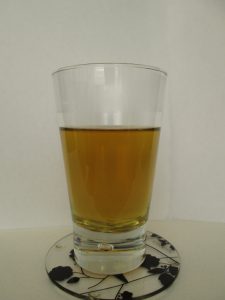
Making your own homemade mouthwash is easy and inexpensive.
I did some research online, and concluded that it was best to use water and baking soda as the main ingredients.
Why baking soda?
Baking soda, or sodium bicarbonate, is used in some commercial mouth washes and even toothpaste.
Halitosis (bad breath) is usually caused by anaerobic bacteria, since they release volatile sulfur compounds (VSCs) as they break down food.
Baking soda can balance the pH in your mouth, so that fewer of these bacteria can thrive. In addition, it has a deodorant effect.
Many commercial mouthwashes use alcohol, but it can dry your mouth (potentially causing more bad breath later on). That’s why I decided against it.
Also, the use of a highly effective antibacterial compound will kill all the bacteria (even the benevolent ones). There’s no need to be so radical when dealing with your mouthwash 🙂
I tried the mixture of water and baking soda as a mouthwash, but the problem I had was that it doesn’t taste well. It’s pretty bland by itself.
Adding green tea
Good news is, you can use green tea instead of water! Brewed tea is made up mostly of water anyway, and it has antibacterial properties as well.
A study in 2008 discovered that green tea was effective in removing VSCs. In contrast, sugarless gum, mints or parsley-seed oil had little effect. However, this effect is only temporary because no reduction is observed one hour later.
 Green tea mouthwash recipe
Green tea mouthwash recipe
First make a cup of green tea.
In my case, I used bancha leaves and brewed them in boiling water for a minute. It doesn’t matter if it’s a bit strong, since you’re not going to drink it.
You can use any green tea you want. I just opted for bancha because it’s not expensive.
Once it cools a little, add 1 teaspoon of baking soda. You’ll see that the color changes, becoming darker.
 The last step is optional. I decided to add a bit of ground ginger for an improvement in taste and also because of it’s antibacterial properties.
The last step is optional. I decided to add a bit of ground ginger for an improvement in taste and also because of it’s antibacterial properties.
If you want to make a larger batch, it will last for at least a month in a sealed container.
As always, consult with your dentist. Halitosis can have many other causes, so it’s best to talk to a specialist first.
Finally, if you worry that this mouthwash may stain your teeth (as green tea can possibly do), just flush with water afterwards.
Sources:
A review of the current literature on management of halitosis
Effect of green tea on volatile sulfur compounds in mouth air
Dentifrices and mouthwashes ingredients and their use

February 18, 2014
Thank you for sharing – I must give this a try.
February 18, 2014
I think this a wonderful idea, I am definitely going to give it a try. Such a gentle and natural alternative to the commercial mouthwashes. Thanks for sharing.
February 19, 2014
If (green) tea has anti bacterial properties, we might as well just drink it after swirling it around in the mouth. Of course without adding the baking soda or anything else. Shouldn’t tea alone remove the anaerobic bacteria that causes halitosis?
February 19, 2014
Hi Lochan
Sure, you could use tea alone.
However, the effect with baking soda lasts more, because it’s a better deodorant and balances pH.
Note that green tea is only effective against some types of bacteria, not all.
August 5, 2014
I always swish my mouth out with green tea in the morning and night. Dental visits are short and no cavities! Baking soda is good too. I gag during oil pulling so, green tea worked best for me. 🙂
August 5, 2014
Thanks for your comment Krystal.
Good to hear that green tea works for you 🙂
October 18, 2015
Krystal,
You said you gag during oil pulling. How do you gag during oil pulling using green tea?? I know about oil pulling where you put TBSp of oil in your mouth and swish for about 20 mins. How long to swish with green tea? Can you share your green tea recipe? Do you use normal tap water to make a batch of green tea for a week?
October 19, 2015
Mark,
I think you misunderstood. I wrote, I gagged with oil pulling. Not green tea. Green tea, is not oil. I am not a fan of swishing oil in my mouth because of the taste and consistency so it makes me gag. I just boil some green tea, let it cool a bit and swish it around my mouth for 5 minutes. I do it until I would drink all the tea in my cup.
August 11, 2019
I know this article was a few years ago but I’m happy I came across it. Making the mouthwash right now.
September 8, 2019
Would you advise against adding a few drops of essential oils like peppermint ( to improve taste? Or tea tree for additional antibacterial boost?
September 8, 2019
Hi Onica
You can add more ingredients if you prefer, it’s not a problem.
September 18, 2019
Essential oils are not a good idea with this recipe. While essential oils are technically not an oil, they are hydrophobic. This means they will just sit at the top, and rinsing with straight essential oil can even cause burns depending on the oil. If you want to add flavor, extract (like used in baking) or another tea is your best bet. I use a mint green tea to make mine. You can also sweeten with xylitol or stevia.